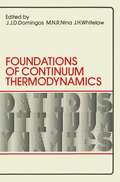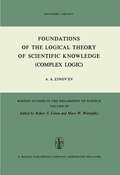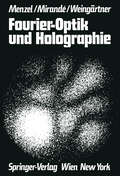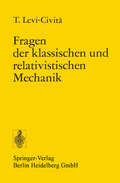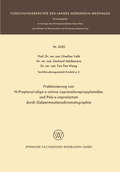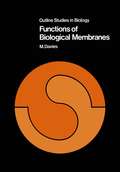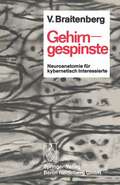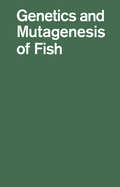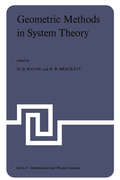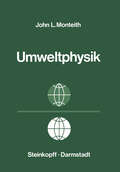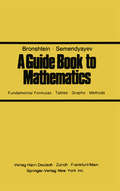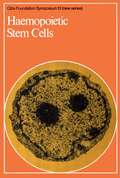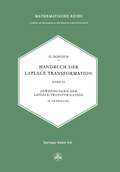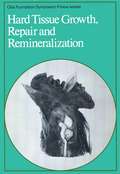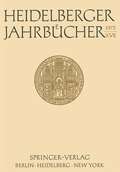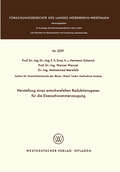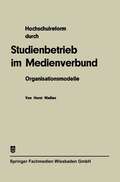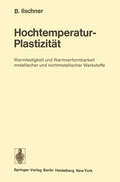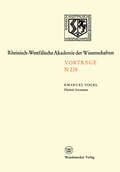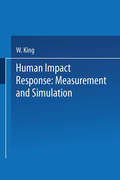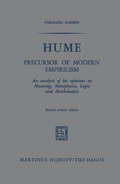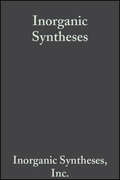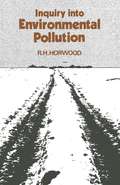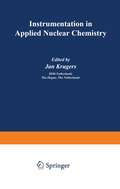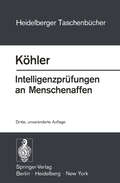- Table View
- List View
Foundations of the Logical Theory of Scientific Knowledge (Boston Studies in the Philosophy and History of Science #9)
by A.A. Zinov'evBoston Studies in the Philosophy of Science are devoted to symposia, con gresses, colloquia, monographs and collected papers on the philosophical foundations of the sciences. It is now our pleasure to include A. A. Zi nov'ev's treatise on complex logic among these volumes. Zinov'ev is one of the most creative of modern Soviet logicians, and at the same time an innovative worker on the methodological foundations of science. More over, Zinov'ev, although still a developing scholar, has exerted a sub stantial and stimulating influence upon his colleagues and students in Moscow and within other philosophical and logical circles of the Soviet Union. Hence it may be helpful, in bringing this present work to an English-reading audience, to review briefly some contemporary Soviet investigations into scientific methodology. During the 1950's, a vigorous new research program in logic was under taken, and the initial published work -characteristic of most Soviet pub lications in the logic and methodology of the sciences - was a collection of essays, Logical Investigations (Moscow, 1959). Among the authors, in addition to Zinov'ev himself, were the philosophers A. Kol'man and P. V. Tavanec, and the mathematicians and linguists, S. A. Janovskaja, A. S. Esenin-Vol'pin, S. K. Saumjan, G. N. Povarov.
Fragen der Klassischen und Relativistischen Mechanik: Vier Vorträge Gehalten in Spanien im Januar 1921
by Tullio Levi-CivitaFraktionierung von N-Propionyl-oligo-ε-aminocapronsäurepropylamiden und Poly-ε-caprolactam durch Gelpermeationschromatographie (Forschungsberichte des Landes Nordrhein-Westfalen)
by Giselher ValkGehirngespinste: Neuroanatomie für kybernetisch Interessierte
by Valentin BraitenbergIch glaube, daß das interessanteste Forschungsobjekt dieser Welt, abgesehen von der Welt selbst, das menschliche Gehirn ist. So wie eines Tages die Einsicht in das Wesen der Materie gewaltige Verände rungen in unserem Denken zur Folge haben wird, ähnlich erschütternd wird, glaube ich, das volle Verständnis der Weise sein, wie das Ge hirn als ein Teil der Natur uns auch die Kenntnis der Natur vermittelt. Ich kann mir auch denken, daß die Erklärung der Materie erst auf die Erklärung des Gehirns zu warten hat, um mit ihr zusammen das ge schlossene Bild der Welt zu ergeben, das die Philosophen suchen. Der Zweck dieses Buches ist, gemessen an den weitschweifenden Gedanken, bescheiden. Es besteht aus lose zusammenhängenden Kapiteln, alle offen, keines endgültig, insgesamt weit entfernt von dem Anspruch, ein Lehrbuch der Gehirnwissenschaften abzugeben. Es sollte verstanden werden als eine kurze Einladung in die Welt unserer Laboratorien, mit einer Schau unserer hübschesten For schungsobjekte und mit Diskussionen, die nicht unbedingt über zeugen, sondern eher eine Atmosphäre vermitteln wollen.
Genetics and Mutagenesis of Fish: Dedicated to Curt Kosswig on his 70th Birthday
by Johannes Horst SchröderGeometric Methods in System Theory: Proceedings of the NATO Advanced Study Institute held at London, England, August 27-September 7, 1973 (Nato Science Series C: #3)
by R. W. Brockett D. Q. MayneGeometric Methods in System Theory In automatic control there are a large number of applications of a fairly simple type for which the motion of the state variables is not free to evolve in a vector space but rather must satisfy some constraints. Examples are numerous; in a switched, lossless electrical network energy is conserved and the state evolves on an ellipsoid surface defined by x'Qx equals a constant; in the control of finite state, continuous time, Markov processes the state evolves on the set x'x = 1, xi ~ O. The control of rigid body motions and trajectory control leads to problems of this type. There has been under way now for some time an effort to build up enough control theory to enable one to treat these problems in a more or less routine way. It is important to emphasise that the ordinary vector space-linear theory often gives the wrong insight and thus should not be relied upon.
A Guide Book to Mathematics: Fundamental Formulas · Tables · Graphs · Methods
by BRONSHTEINTO THE FIRST RUSSIAN EDITION It was a very difficult task to write a guide-book of a small size designed to contain the fundamental knowledge of mathema tics which is most necessary to engineers and students of higher technical schools. In our tendency to the compactness and brevity of the exposition, we attempted, however, to produce a guide-book which would be easy to understand, convenient to use and as accurate as possible (as much as it is required in engineering). It should be pointed out that this book is neither a handbook nor a compendium, but a guide-book. Therefore it is not written as systematically as a handbook should be written. Hence the reader should not be surprised to find, for example, I'HOpital's rule in the section devoted to computation of limits which is a part of the chapter "Introduction to the analysis" placed before the concept of the derivative, or information about the Gamma function in the chapter "Algebra"-just after the concept of the factorial. There are many such "imperfections" in the book. Thus a reader who wants to acquire certain information is advised to use not only the table of contents but also the alpha betical index inserted at the end of the book. If a problem mentioned in the text is explained in detail in another place of the book, then the corresponding page is indicated in a footnote.
Haemopoietic Stem Cells (Novartis Foundation Symposia #13)
by G. E. W. Wolstenholme Maeve O'ConnorThe Novartis Foundation Series is a popular collection of the proceedings from Novartis Foundation Symposia, in which groups of leading scientists from a range of topics across biology, chemistry and medicine assembled to present papers and discuss results. The Novartis Foundation, originally known as the Ciba Foundation, is well known to scientists and clinicians around the world.
Handbuch der Laplace-Transformation: Band 3: Anwendungen der Laplace-Transformation (Lehrbücher und Monographien aus dem Gebiete der exakten Wissenschaften #19)
by G. DoetschDer vorliegende Band III bildet mit dem früher erschienenen Band II ein Ganzes, was auch äusserlich dadurch zum Ausdruck kommt, dass die Teile und Kapitel anschliessend an die von Band II weiternumeriert sind. Gegenüber der früheren Darstellung in meiner Monographie ~Theorie und Anwendung der Laplace-Transformation» von 1937 hat sich auch in diesem. Band der Stoff auf allen Gebieten stark ausgeweitet. Manches ist ausführlicher dargestellt, anderes ganz neu hinzugekommen, wie die Kapitel über partielle Differentialgleichungen mit variablen Koeffizienten, Kompatibilitätsbedingungen für Randwertprobleme, Differenzengleichungen, Integralgleichungen im unendlichen Intervall, verschie dene mit Laplace-Transformation lösbare Integralgleichungen und ganze Funk tionen vom Exponentialtypus. Letztere bieten ein schier unerschöpfliches Feld für Anwendungen der Laplace-Transformation, und die dargestellten Unter suchungen möchten zu weiteren Forschungen auf diesem Gebiet anregen. Bei den Funktionalgleichungen sei besonders auf die Differenzengleichungen verwiesen, deren Behandlung mit Laplace-Transformation hier zum erstellmal in Buchform vollständig dargestellt ist. An Hand der Theorie der Kettenleiter, der Schrittregler und ähnlicher Probleme ist in letzter Zeit in der Technik ein neu es Interesse an den Differenzengleichungen erwacht, und für die hier vorliegenden Fragen dürfte insbesondere das 22. Kapitel brauchbare Methoden liefern.
Hard Tissue Growth, Repair and Remineralization (Novartis Foundation Symposia #11)
by Katherine Elliott David W. FitzSimonsThe Novartis Foundation Series is a popular collection of the proceedings from Novartis Foundation Symposia, in which groups of leading scientists from a range of topics across biology, chemistry and medicine assembled to present papers and discuss results. The Novartis Foundation, originally known as the Ciba Foundation, is well known to scientists and clinicians around the world.
Heidelberger Jahrbücher XVII (Heidelberger Jahrbücher #17)
by Hans Walter Wolff Günter Menges Jacob Marschak Hellmut Salowsky Bert Nagel Hans-Ulrich Kolb Joachim Telle Rolf Binner Erika Kollnig-Schattschneider Hermann Glockner Walter Henss Hans SchaeferHerstellung eines entschwefelten Reduktionsgases für die Eisenschwammerzeugung (Forschungsberichte des Landes Nordrhein-Westfalen #2297)
by Hermann SchenckHochtemperatur-Plastizität: Warmfestigkeit und Warmverformbarkeit metallischer und nichtmetallischer Werkstoffe (Reine und angewandte Metallkunde in Einzeldarstellungen #23)
by Bernhard IlschnerHückel-Aromaten: 187. Sitzung am 4. März 1970 in Düsseldorf (Rheinisch-Westfälische Akademie der Wissenschaften #228)
by Emanuel VogelHume: Precursor of Modern Empiricism
by Farhang ZabeehDavid Hume is the most influential precursor of modern empiri cism. By modern empiricism, I intend a belief that all cognitive conflicts can be resolved, in principle, by either appeal to matters off act, via scientific procedure, or by appeal to some sets of natural or conventional standards, whether linguistic, mathematical, aes thetic or political. This belief itself is a consequent of an old appre hension that all synthetic knowledge is based on experience, and that the rest can be reduced to a set of self-evident truths. In this broad sense, Modern Empiricism encompasses classes, such as Logi cal Empiricism, Logical Atomism and Philosophical Analysis, and unique individuals such as Russell and Moore. It excludes, thereby, the present day continental philosophies, such as Thomism, Exist entialism, and Dialectical Materialism. Modem empiricists, to be sure, are influenced by many other phi losophers. Locke, Berkeley, and Mill, among the classical empiri cists, and Leibniz and Kant, among the rationalists (the former especially on the logico-mathematical side) in one way or other are responsible for the appearance of empiricism in its new form. But none of them were as influential as Hume. This, by itself is not news. Weinberg, in his well-known book, An Examination of Logical Positivism, observes that: Many, if not all, of the principal doctrines of contemporary positivism derive from Hume.
Inorganic Syntheses (Inorganic Syntheses #14)
by Aaron Wold John K. RuffThe volumes in this continuing series provide a compilation of current techniques and ideas in inorganic synthetic chemistry. Includes inorganic polymer syntheses and preparation of important inorganic solids, syntheses used in the development of pharmacologically active inorganic compounds, small-molecule coordination complexes, and related compounds. Also contains valuable information on transition organometallic compounds including species with metal-metal cluster molecules. All syntheses presented here have been tested.
Instrumentation in Applied Nuclear Chemistry
by Jan KrugersThis book attempts to build a bridge between two sciences: chemistry and electronics. The inside of the black boxes the nuclear chemist uses daily is explained in simple electronic terms. Knowledge of the inside not only satisfies curiosity but helps one "get the most out of the available equipment." Likewise, this book tries to give sufficient understanding for not "over buying," that is to say, for buying the equipment which just serves the purpose, instead of buying the best so at least it will serve the purpose. The first three chapters give a concise understanding of what the area of applied nuclear chemistry is concerned with and what kind of equipment is generally used. Chapter 1 gives a theoretical background, while Chapter 3 deals with the practical implementations. Thus, these chapters provide the background to determine what one can expect from the experiments. The remainder of the book is devoted to the practical instrumentation of the experiments. Each chapter deals with specific types of instruments and devices, discusses briefly the electronics involved, considers the limitations, and investigates how and to what extent they can be circumvented. The advantage of having different contributors, each with his own practical experience, shows clearly in this latter aspect. Detailed practical knowledge and experience can be explained best by the person who has long been con cerned with the subject theoretically and practically.
